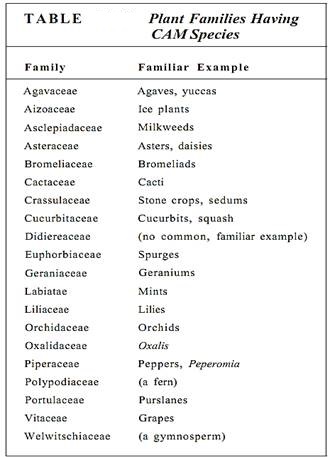


 النبات
النبات
 الحيوان
الحيوان
 الأحياء المجهرية
الأحياء المجهرية
 علم الأمراض
علم الأمراض
 التقانة الإحيائية
التقانة الإحيائية
 التقنية الحيوية المكروبية
التقنية الحيوية المكروبية
 التقنية الحياتية النانوية
التقنية الحياتية النانوية
 علم الأجنة
علم الأجنة
 الأحياء الجزيئي
الأحياء الجزيئي
 علم وظائف الأعضاء
علم وظائف الأعضاء
 الغدد
الغدد
 المضادات الحيوية
المضادات الحيوية|
Read More
Date: 10-10-2016
Date: 27-10-2016
Date: 23-10-2016
|
Crassulacean Acid Metabolism
Crassulacean acid metabolism (CAM) is a second metabolic adaptation that improves conservation of water while permitting photosynthesis. It is so named because it was first discovered in those members of the family Crassulaceae that have succulent leaves (Fig., Table ). The metabolism is almost identical to that in C4 plants: PEP is carboxylated, forming oxaloacetate, which is then reduced to malate or other acids. These acids are not transported but simply accumulate, in effect storing carbon dioxide. This occurs at night These plants differ from C3 and C4 plants in that their stomata are closed during the hottest periods and open only at night when it is cool. Coolness reduces transpiration, and usually air is calmer at night so water molecules near stomata are not blown away immediately and may diffuse back into the plant. Opening stomata at night is effective for conserving water, but the lack of light energy creates a problem for photosynthesis: A plant cannot store ATP and NADPH during the day for use at night; they are not stable enough and each d has too little. Hence, carbon dioxide is stored on acids until daytime, when stomata doe and the malate or other acids break down, releasing carbon dioxide for C3 metabolism. The released carbon dioxide cannot escape because stomata close at dawn.
Crassulacean acid metabolism is not particularly efficient; the total amount of carbon dioxide is so small that it may be entirely used in C3 metabolism after just a few hours of sunlight Furthermore, RuBP carboxylase is protected from photorespiration only in the morning when internal carbon dioxide levels are high. Later in the day, photorespiration may be high, but the carbon dioxide released by the breakdown of phosphoglycolate is trapped and re-fixed.

FIGURE : (a) Sempervivum arachnoideum, a member of the Crassulaceae. like many desert succulents, it has CAM metabolism as well as other adaptations that conserve water. (b) This large barrel cactus (Echinocactus) and short pincushion cactus (Mammillaria) are CAM plants. (c) Photosynthetic cells of CAM plants have large vacuoles, a feature that permits the accumulation of C4 acids.
Crassulacean acid metabolism is selectively advantageous in a hot, very dry climate where survival rather than rapid growth is most important. In these habitats, unaided C3 metabolism is so wasteful of water that C3 plants cannot survive. In the most arid regions, C4 plants barely get by, growing in slightly less stressful microhabitats such as near temporary streams and ponds, or growing and flowering quickly during the cool, moist months of winter and spring, then dying in the summer and surviving only as seeds. Under such conditions, CAM plants have a selective advantage; they may not grow luxuriantly, but they do grow and reproduce more succesfully than C3 and C4 plants.

Under milder, moister conditions, crassulacean acid metabolism is not selectively advantageous. Water conservation is less of a benefit, and the limited capacity to absorb and store carbon dioxide is a distinct disadvantage. C3 and C4 plants photosynthesize all day, whereas CAM plants may stop before noon.
Crassulacean acid metabolism has evolved several times and is also present in the cactus family, many orchids, bromeliads, lilies, and euphorbias. All have other metabolic and structural adaptations for water conservation, such as succulent bodies filled with water-storing parenchyma and covered by a tough epidermis with a thick cuticle and wax layer.



|
|
|
|
4 أسباب تجعلك تضيف الزنجبيل إلى طعامك.. تعرف عليها
|
|
|
|
|
|
|
أكبر محطة للطاقة الكهرومائية في بريطانيا تستعد للانطلاق
|
|
|
|
|
|
|
العتبة العباسية المقدسة تبحث مع العتبة الحسينية المقدسة التنسيق المشترك لإقامة حفل تخرج طلبة الجامعات
|
|
|